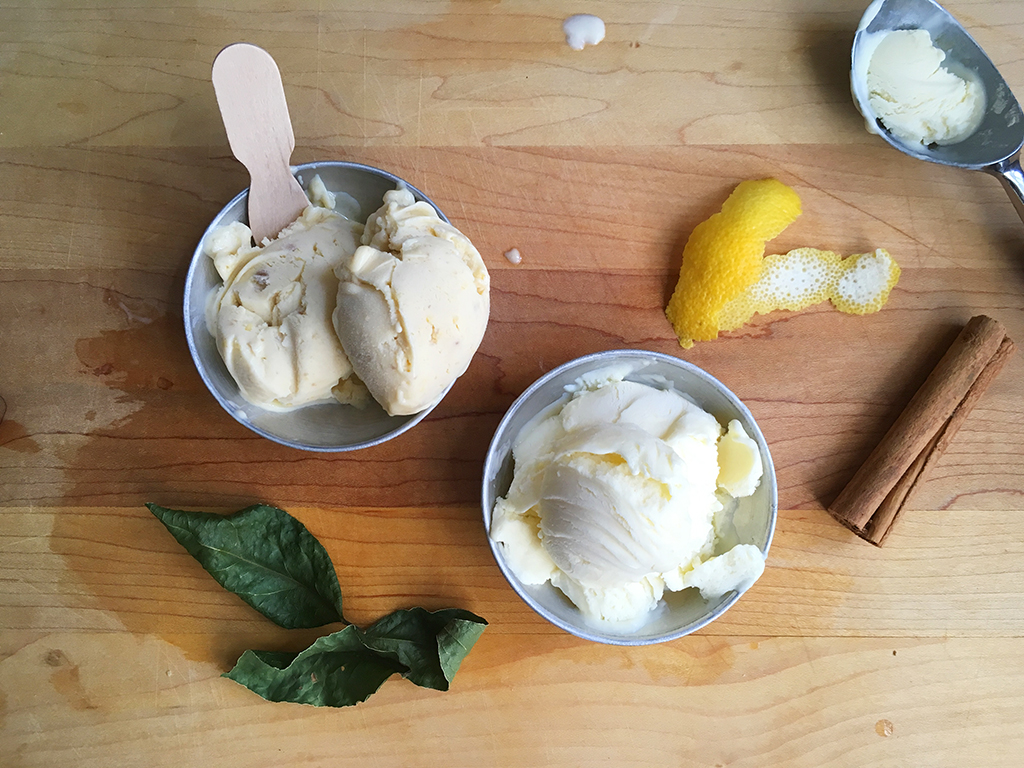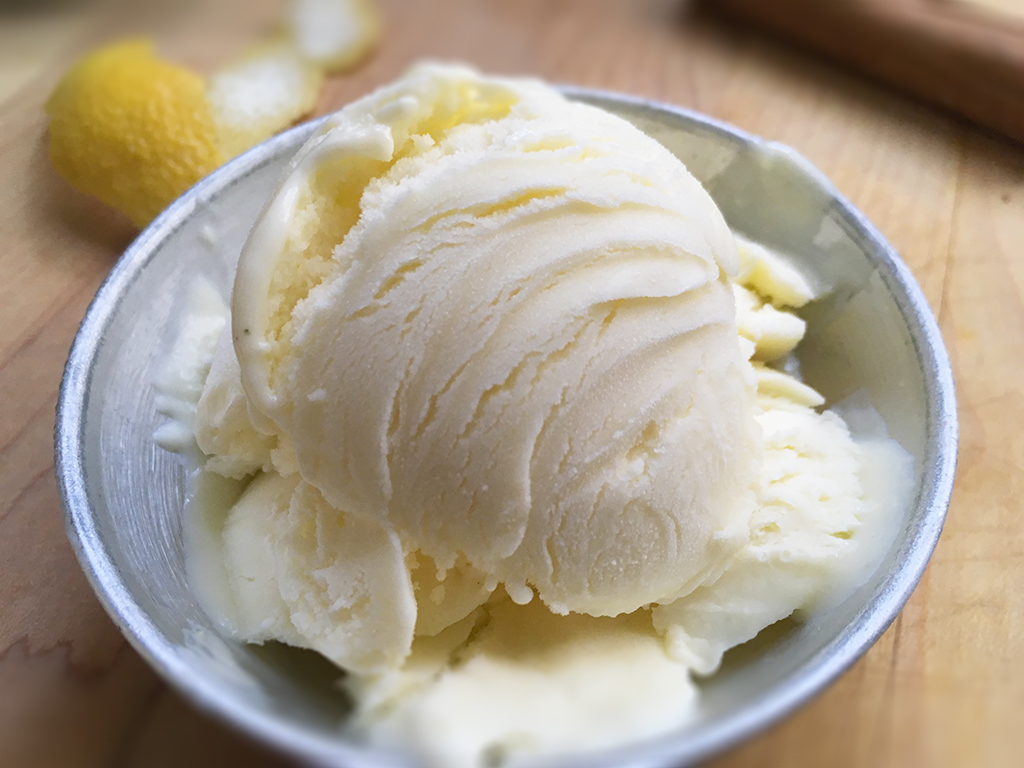 Left: pumpernickel. Right: Cinnamon/bay leaf/lemon.
Left: pumpernickel. Right: Cinnamon/bay leaf/lemon.
Here in New York City it has been HOT. But here’s my solution: I made two fascinating flavors of historic ice cream. Brown Bread ice cream, infused with actual pumpernickel bread, and a cinnamon-bay leaf-lemon ice cream made with fresh bay leaves.
The History
The spark of inspiration to make both these recipes came from my favorite book on ice cream history, Of Sugar and Snow: A History of Ice Cream Making. The author, Jeri Quinzio, explained the rye bread ice cream appeared in the first book completely dedicated to ice cream making, written by a “Monsieur Emy” in France in 1768. Rye bread crumbs are infused in the cream, but are strained out before freezing. A popular 19th century flavor, later recipes added toasted rye bread crumbs just before freezing for a bit of crunch, but Emy’s was a smooth ice cream.
The second recipe I tried was called “Cinnamon Ice Cream (Creme de Cannelle),” from Agnes Marshall’s Book of Ices, published in 1885. Marshal was an ice cream genius, and I’ve written about her before. She was the first person to suggest using liquid nitrogen to freeze ice cream. Her recipes are genius, to the point of madness–like her savory Neapolitan made with tomatoes, artichokes, and peas.
Her cinnamon ice cream featured a stick of ceylon cinnamon, the zest of half a lemon, and a bay leaf. I had purchased a fresh bay leaf plant for just this recipe. A fresh bay leaf is dramatically different from dried: vegetal and aromatic, I wanted its special flavor for my crazy ice cream.
The Recipe
 It’s pumpernickely!
It’s pumpernickely!
For both of these recipes, I started with a basic custard ice cream:
Custard Ice Cream
- 2 cups heavy whipping cream
- 1 cup whole milk
- 1 vanilla bean (or, other flavoring of your choice)
- 6 large egg yolks
- 3/4 cup sugar
- 1/4 teaspoon coarse salt
- Additional mix-ins
Add split and scraped vanilla bean to cream and milk in a saucepan. Bring to a boil. In the meantime, in a glass bowl whisk together egg yolks, sugar and salt until blended. After cream mixture comes to a boil, pour slowly on the egg mixture, whisking constantly. Return to saucepan and cook over low heat, stirring constantly with a wooden spoon, until custard thickens slightly and evenly coats back of spoon (it should hold a line drawn by your finger). Pour custard through a fine-mesh sieve into a bowl set over ice, or place in refrigerator, until chilled–overnight is preferable. Churn in an ice-cream maker according to manufacturer’s instructions, adding mix-ins like nuts or fruits in the last few minutes of freezing. Transfer ice cream to a resealable plastic container and freeze until firm, about 2 hours.
For Pumpernickel Ice Cream: Toast 2 cups of pumpernickel bread until deep brown on the edges. Add to milk and cream and bring to a boil. Remove from heat, and allow to infuse for two minutes. Proceed as recipe directs.
For Cinnamon Ice Cream: To milk and cream, add “a finger-length” of Ceylon cinnamn (about 4 inches), 1 bay leaf, and the peel of half a lemon. Cut the peel off the lemon with a pairing knife, taking care to avoid the white pith. Bring milk, cream, and spice to a boil; remove from heat and allow to infuse 2 minutes. Proceed with recipes as directed.
I also made this fun little video of all the steps to make these ice creams; enjoy and I hope it’s helpful!
The Results
 Cinnamon ice cream perfection.
Cinnamon ice cream perfection.
The pumpernickel ice cream was genuinely repulsive. It has a mucus-like texture I noticed even before I froze it, some strange gooey quality infused from the bread. The flavor of the pumpernickel gave the ice cream an assertive savory-sweet taste, as though I had made ice cream from an entire McDonald’s hamburger, ketchup, pickles and all.
But the cinnamon ice cream–oh! Interestingly, cinnamon is not the flavor I would have assigned to it. The flavor, delicate and complex, would be unidentifiable if you weren’t informed. There’s a greeness from the bay leaf, a gentle citus from the lemon zest, and a soft floral quality from the ceylon cinnamon. The combination goes perfectly with the texture of the custard. It’s a real winner, and the ice cream you should make to cool you down in the dog days of summer.


Really, really going to have to try this! I’ve been looking for a fun use for the bay tree outside the front door ;) Thanks for sharing.
Let me know how it goes, Emma!
I have been somewhat obsessed by rye bread ice cream for a while, so I was excited when your post came across my blog feed. I was amazed to see that rye bread recipes had been written in the 18th century.
My obsession began when I read about the infamous whale meat luncheon of 1918 in “Leviathan” by Eric Jay Dolin. On that menu it was called “Ice Cream, bisque of black bread a la Delmonico’s”. I wasn’t quite sure what this dish was, but a lucky series of events in 2016 led me to a cookbook by one of the chefs at Delmonico’s which had a recipe for rye bread ice cream (link below).
It’s too bad that the rye bread ice cream was so terrible. I have heard of credible authors promoting “Brown Bread Ice Cream” (e.g., David Lebovitz), so I wonder if there is something very different about the rye bread you used compared to the bread of Monsieur Emy’s or Ranhofer’s day? Or are there many ways to make bread-flavored ice creams?
I don’t have access to an ice cream maker, so I won’t have a chance to make it soon, but have been looking into recipes that don’t require an ice cream maker (and then I’ll make 1/4 of a recipe to be safe…).
Mmmmm…Rye Bread Ice Cream, or Solving the Mystery of “Ice Cream, Bisque of Black Bread”: http://marcsala.blogspot.com/2016/05/rye-bread-ice-cream.html
I used Russ & Daughter’s rye bread, which is some of the best out there. and actually from a very old world recipe. But just because this recipe didn’t turn out, and I didn’t like it, doesn’t mean there’s not some other perfect recipe out there, or that someone else would like this more! But i can’t imagine how else to make it than soaking the bread. If you ever get a chance to try it or make it, let me know–I’ve been obsessed with it for a while too! It was apparently very popular in the 18th c.
Thanks for the shout out. I haven’t made rye or brown bread ice cream, but have eaten the latter at a restaurant. It had a lovely nutty flavor. If I make some, I’ll let you known. Cinnamon ice cream is one of my favorites, now I have to get some fresh bay leaves to try.
Looking forward to reading your new book. Best, Jeri
Hi Jeri! You’ll love the cinnamon with lemon and bay; it was really exceptional!
Thanks for commenting–and I hope you enjoy my book! I definitely enjoyed yours.
Pingback: The 19th-century entrepreneur who pioneered modern ice cream
Pingback: The 19th-century entrepreneur who was an ice cream pioneer
Pingback: The 19th-century entrepreneur who pioneered modern ice cream – Stirile Online
Pingback: Zelf ijs maken zonder een ijsmachine - Lauriekoek